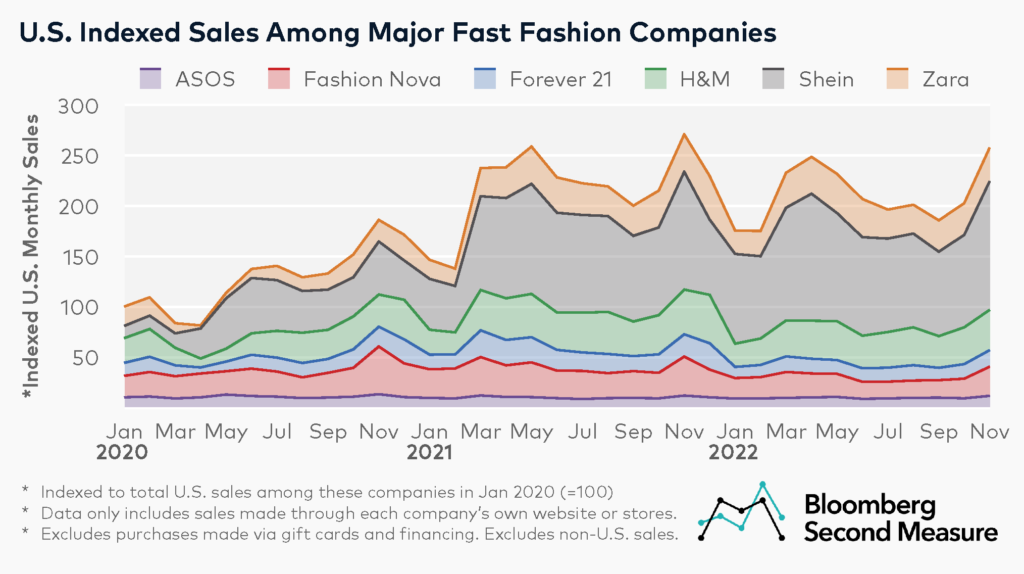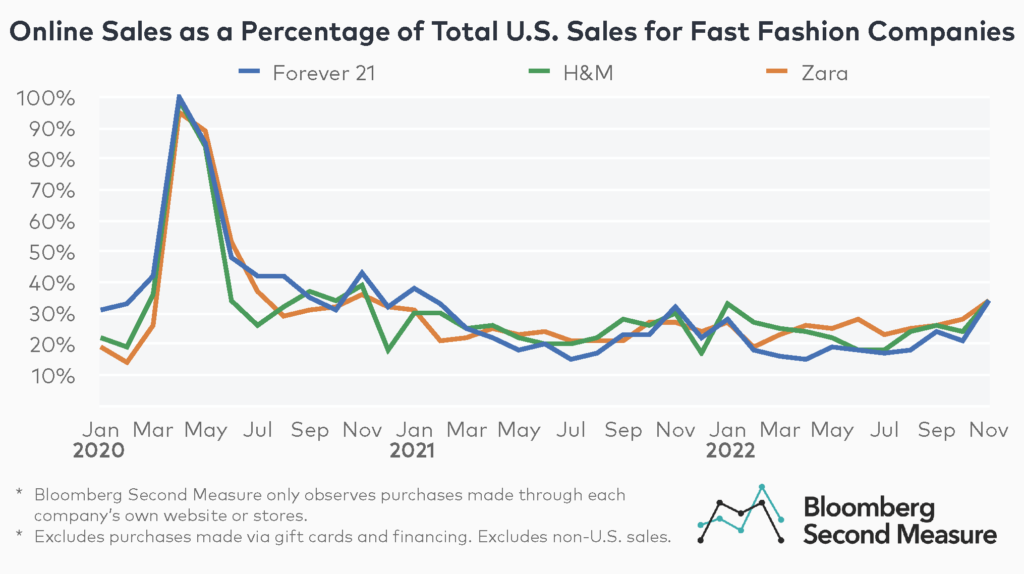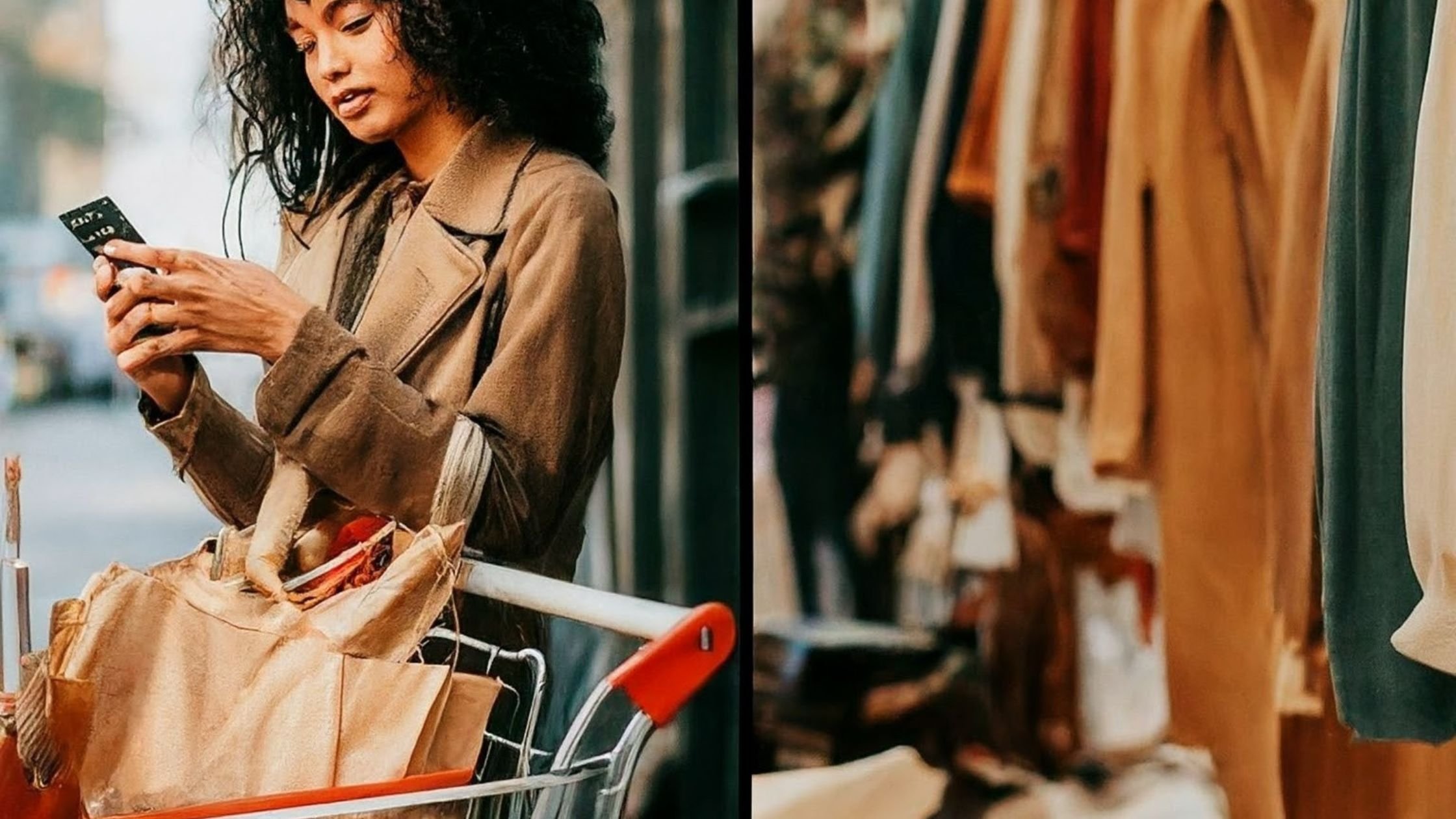
Navigating New Era of Retail: BlackFriday Trends to Sustainable Fashion

The retail world is a never-ending rollercoaster ride, constantly shifting and changing as consumers and retailers play their parts. Recent insights from Bloomberg on Black Friday sales, combined with the growing influence of fast fashion brands, paint a vivid picture of this ever-evolving landscape. Black Friday, once a surefire success for physical stores, now presents a more intricate and unpredictable scenario. While Amazon continues to dominate the market, traditional retailers are left grappling with unexpected challenges, showcasing the increasing importance of "value and convenience."
Source: Bloomberg Second Measure
Note: Share of observed sales is relative to a standardized year-to-date period.
But for most other retailers Bloomberg analyzed, Black Friday spending fell, in some cases by double digits
Sales Disappoint for Retailers Most Reliant on Black Friday
Black Friday share of observed sales vs change in Black Friday sales
Source: Bloomberg Second Measure
Note: Share of observed sales is relative to a standardized year-to-date period. Capri Holdings is t
In this blog post, we explore how trailblazing brands like Buda Jeans Co, a part of Reliance Retail's AJIO in India, are revolutionizing the industry by integrating sustainability into their core values. These brands cater to consumers who value both affordability and global standards.
The world of retail is in a state of constant flux, driven by the ever-changing preferences of consumers and the unstoppable rise of online giants. Black Friday, which was once a predictable frenzy for brick-and-mortar stores, now presents a more intricate picture. While Amazon continues to dominate the market, traditional retailers are facing unexpected challenges, reflecting the growing importance of value and convenience in today's economic climate.
The Black Friday Phenomenon and the Rise of Fast Fashion
The phenomenon of Black Friday sales paints a complex and multifaceted picture of the retail world. On one hand, traditional retail outlets grapple with fluctuating fortunes. On the other, online platforms and discount behemoths like Amazon and Walmart bask in significant gains, highlighting a discernible pivot toward value-driven shopping. This shift is the wind beneath the wings of fast fashion brands such as Shein, H&M, and Zara, who have adeptly capitalized on their ability to rapidly adapt to emerging trends, significantly aided by digital platforms, to become the go-to for a large segment of shoppers.
 Temu, the Fast-Fashion Juggernaut, Rises:
Temu, the Fast-Fashion Juggernaut, Rises:
Fast fashion has experienced remarkable growth over recent years. In 2020, the market was valued at $68.6 billion, with projections suggesting it could rise to nearly $212 billion by 2030. This surge is attributed to brands like H&M, Zara, and newer e-commerce players like SHEIN, Asos, and Boohoo. 
These companies have mastered the art of rapidly producing affordable, trendy clothing, heavily leveraging social media platforms and influencer marketing to reach consumers.
Source: Bloomberg Second Measure
Note: Indexed to Shein's observed metrics in May 2022 (=100). Data track gross merchandise value for Temu's sales.
Enter Temu, the fast-fashion behemoth that has taken the US market by storm with its breakneck speed and budget-friendly offerings. Backed by the Chinese e-commerce giant PDD, Temu surpassed Shein, its main rival, in US sales as early as May 2023, and the gap has only widened since then. According to data from Bloomberg Second Measure, Temu's US transactions in November were nearly triple those of Shein.
Fast Fashion: A Double-Edged Sword
Valued at a staggering $68.6 billion in 2020, and projected to skyrocket to almost $212 billion by 2030, the fast fashion industry is on an unprecedented ascent. These brands have perfected the art of leveraging social media and influencer marketing, appealing predominantly to young adults who face the societal pressure of showcasing a diverse wardrobe across social settings. However, this rapid consumption model casts a long shadow, marked by significant sustainability concerns ranging from environmental impact to ethical labor practices.
But a Shadow Looms Over Fast Fashion's Triumph:
Temu's meteoric rise, however, comes amidst a worrying trend: tightening consumer belts. While discounters like Walmart and TJX Companies thrived during Black Friday, brands catering to the upper-middle class witnessed their biggest sales drop in two years. This disparity highlights the growing importance of "affordability and value" in today's economic climate.
A Beacon of Hope: Sustainable Fashion Emerges
Buda Jeans Co: A Case Study in Sustainable Fashion
Amid the shopping frenzy, a shining ray of hope appears in the form of sustainable fashion pioneers like Buda Jeans Co. These innovative brands demonstrate that fashion and sustainability can go hand in hand, offering a promising way forward. By embracing eco-friendly materials, ethical production practices, and transparent supply chains, they lead the charge toward a more conscious future of fashion.
In stark contrast to this backdrop, we find Buda Jeans Co, a subsidiary of AJIO and part of Reliance Retail in India. Buda Jeans Co has made sustainability a fundamental principle, recognizing the importance of balancing affordability with global quality standards. Their approach revolves around three key aspects:
- Eco-Friendly Materials: A strong commitment to using sustainable materials in their denim production.
- Ethical Manufacturing: Adhering to fair labor practices while minimizing environmental impact.
- Affordable Quality: Meeting the demand in the Indian market for fashion that is both affordable and of high quality.
This unwavering dedication to sustainability sets Buda Jeans Co. apart and positions them as leaders in the industry.
The Digital Transformation: E-Commerce Takes Center Stage
The digital transformation of the retail sector has been nothing short of revolutionary. E-commerce platforms have disrupted traditional retail models, offering unparalleled convenience and a seemingly endless variety of options. This shift has been particularly pronounced during Black Friday sales, where online giants like Amazon have reported record-breaking numbers. The secret to their success lies in their ability to understand and cater to evolving consumer preferences, leveraging data analytics to personalize the shopping experience.
The Consumer Shift: Value and Experience in the Spotlight
Today's consumers are more informed and discerning than ever before. They seek not just value in terms of price but also value in terms of quality and experience. This shift has led to a decline in the appeal of traditional retail stores, especially during high-traffic events like Black Friday. Consumers are increasingly turning to online platforms that offer not just competitive pricing but also a more personalized and convenient shopping experience.
Sustainability: The New Fashion Imperative
The rise of fast fashion has highlighted a critical issue in the retail industry - sustainability. As consumers become more environmentally conscious, there is a growing demand for brands that offer sustainable and ethically made products. This shift is not just a passing trend but a profound change in consumer mindset. Brands like Buda Jeans Co are leading the way in this area, proving that it is possible to offer fashion that is both stylish and sustainable.
The Impact of Social Media and Influencer Marketing
Social media has revolutionized the way brands interact with their consumers. Platforms like Instagram, TikTok, and Facebook have become pivotal in shaping fashion trends and consumer behaviors. Influencer marketing, in particular, has emerged as a powerful tool for brands to reach a wider audience, especially among the younger demographics. Fast fashion brands have been particularly adept at leveraging these platforms to drive sales and build brand loyalty.
The Challenges of Ethical Manufacturing
While the demand for sustainable fashion is growing, the industry faces significant challenges in terms of ethical manufacturing. Many fast fashion brands have been criticized for their labor practices and environmental impact. The challenge for the industry is to find a way to balance the demand for affordable fashion with the need for ethical and sustainable production practices.
1. Labor Practices and Environmental Concerns:
- Issue: Fast fashion's rapid production cycles often lead to poor labor conditions and environmental degradation. The pressure to reduce costs and speed up production time can result in unsafe working environments and minimal wages for workers.
- Solution Exploration: Implementing stricter labor standards and conducting regular audits. Brands could invest in worker education and development, ensuring fair wages and safe working conditions.
2. Sustainable Production:
- Issue: The traditional linear model of "take-make-dispose" in fashion manufacturing is inherently unsustainable, contributing to resource depletion and waste.
- Solution Exploration: Transitioning to sustainable production methods, like using eco-friendly materials and reducing water and energy usage. This also involves educating consumers about the value of sustainable products to justify potentially higher prices.
3. Supply Chain Transparency:
- Issue: A lack of transparency in the supply chain makes it difficult to ensure ethical practices throughout the production process.
- Solution Exploration: Implementing blockchain or similar technologies to track the lifecycle of a product, from raw materials to the final product. This transparency can build trust with consumers and help ensure compliance with ethical standards.
The Role of Technology in Shaping the Future of Retail
Technology is playing a crucial role in shaping the future of the retail industry. From AI-driven personalization to augmented reality (AR) in virtual try-ons, technological advancements are transforming the way consumers shop. These innovations are not just enhancing the shopping experience but are also helping brands to become more efficient and sustainable in their operations.
1. AI-Driven Personalization:
- Innovation: AI algorithms can analyze customer data to provide personalized shopping experiences, suggest products based on preferences, and improve customer engagement.
- Impact: Enhanced customer satisfaction and loyalty, leading to increased sales and a more intimate understanding of customer needs.
2. Augmented Reality (AR) in Virtual Try-Ons:
- Innovation: AR technology allows customers to try on clothes virtually, reducing the need for physical samples and decreasing returns.
- Impact: This not only enhances the shopping experience but also reduces waste associated with returns and unsold inventory.
3. Sustainable Operations:
- Innovation: Technology can streamline operations, making them more energy-efficient. For instance, implementing automated systems in warehouses can reduce energy consumption.
- Impact: Reduced carbon footprint and operational costs, contributing to a brand's sustainability goals.

Embracing the Circular Economy
The concept of a circular economy is gaining traction in the fashion industry. This model focuses on reducing waste and promoting the reuse and recycling of products. Brands are increasingly adopting this approach, offering services like clothing rentals and second-hand sales. This shift towards a circular economy is not just environmentally responsible but also resonates with the values of the modern consumer.
1. Reducing Waste Through Recycling and Upcycling:
- Approach: Brands can focus on recycling materials from old garments or using upcycled materials to create new products.
- Benefit: This approach not only reduces waste but also creates a unique product offering that can appeal to environmentally conscious consumers.
2. Promoting Reuse with Rental and Second-Hand Services:
- Approach: Offering rental services or platforms for buying and selling second-hand clothing can extend the life cycle of garments.
- Benefit: This reduces the environmental impact and caters to consumers looking for affordable and sustainable fashion options.
3. Design for Longevity:
- Approach: Shifting focus from fast fashion to creating timeless, high-quality pieces that last longer.
- Benefit: Encourages a move away from the disposable culture in fashion, reducing overall consumption and waste.
4. Integration with Technology:
- Approach: Using technology to facilitate the circular economy, like apps for sharing or exchanging clothes, or platforms that connect buyers with local second-hand markets.
- Benefit: Technology can make it easier for consumers to participate in the circular economy, thereby promoting sustainable practices.
The Future of Retail: A Blended Experience
The future of retail is looking pretty exciting! It's all about finding the perfect blend of online and offline experiences. While e-commerce continues to dominate the scene, traditional retail still has its charm, especially for those brands that can create a unique and captivating in-store atmosphere. The key for retailers is to seamlessly integrate their online and offline channels, giving consumers a shopping journey that's personalized and holistic.
As we navigate through this ever-changing landscape, it's clear that the future of fashion retail depends on striking a delicate balance. Brands like Buda Jeans Co are leading the way, showing us that we can cater to consumer demands while also prioritizing environmental and social responsibility. It's all about finding that sweet spot where trends and sustainability go hand in hand.
The retail fashion industry is at a pivotal moment, with fast fashion setting the trends and sustainability becoming a bigger concern. Brands that can find synergy between these two aspects, just like Buda Jeans Co, are not only going to stay relevant but also have the power to shape a more sustainable future. As consumers become more mindful of their choices, it's up to the industry to adapt and make sure that today's trends don't turn into tomorrow's environmental crises.
The future of retail lies in striking the perfect balance between value, convenience, and sustainability. Brands that can navigate this complex landscape and meet the evolving needs of consumers will be the ones that thrive. Let's remember that conscious consumerism and responsible business practices are more than just buzzwords – they're the keys to unlocking a future where style doesn't come at the expense of our planet.
A Multi-Pronged Approach: Brands that want to thrive in this dynamic landscape must embrace a multi-pronged approach.
Competitive pricing: Consumers demand affordability, but not at the cost of quality or ethics. Brands must find ways to offer competitive prices without compromising on these crucial aspects.
Enhanced online presence: The online marketplace is where it's at. Brands must invest in building a strong online presence, leveraging digital platforms effectively to reach their target audience.
Sustainable practices: Consumers are increasingly conscious of the environmental and ethical implications of their clothing choices. Brands that prioritize sustainability will gain a significant edge.
Ethical labor: Fair working conditions and ethical labor practices are no longer optional; they are essential for building trust and loyalty with consumers.
Consumer education: Educating consumers about the importance of sustainable fashion choices empowers them to make informed decisions and support brands that align with their values.
Conclusion: A New Era of Conscious Consumerism
The retail industry is entering a new era marked by conscious consumerism and an emphasis on sustainability. Brands that can adapt to these changing dynamics by offering products that are affordable, trendy, sustainable, and ethically made, will thrive in this new landscape. As consumers, we have the power to shape the industry by supporting brands that align with our values, and create a more sustainable and responsible fashion future.


